Steve Bell, the contemporary political satirist who produces the If… cartoon strip and other editorial pieces for The Guardian, regularly makes reference to political satire of earlier times by re-working it with a contemporary twist. By doing this he is also making satirical references to the past – making a link between the contemporary moment and a similar (or different) historical one.
Look at the work of William Hogarth, James Gillray, George Cruikshank or other eighteenth-century political satirists and pick out examples you think could be successfully re-worked for a contemporary audience. Strip away the layers of eighteenth-century meaning to establish the core symbolism and metaphors that make satire work. Identify what you would replace with what to make this work for a contemporary setting.
Initial Research
I find that some political cartoons are much easier to understand than others. Generally, the viewer is required to have some prior knowledge of the current political or world events being targeted in order to grasp the humour/message being communicated. I feel that the simpler the cartoon, the easier I find it to interpret, for example, I prefer those that are mostly imaged-based rather than having huge amounts of text to read.
Three particular cartoonists that I enjoy the work of are Guy Venables, who produces the daily cartoons in The Metro, Morten Morland, who produces cartoons for The Times and The Sunday Times newspapers, and Nick Newman, who also produces cartoons for The Sunday Times, along with ones for Private Eye and many other publications.
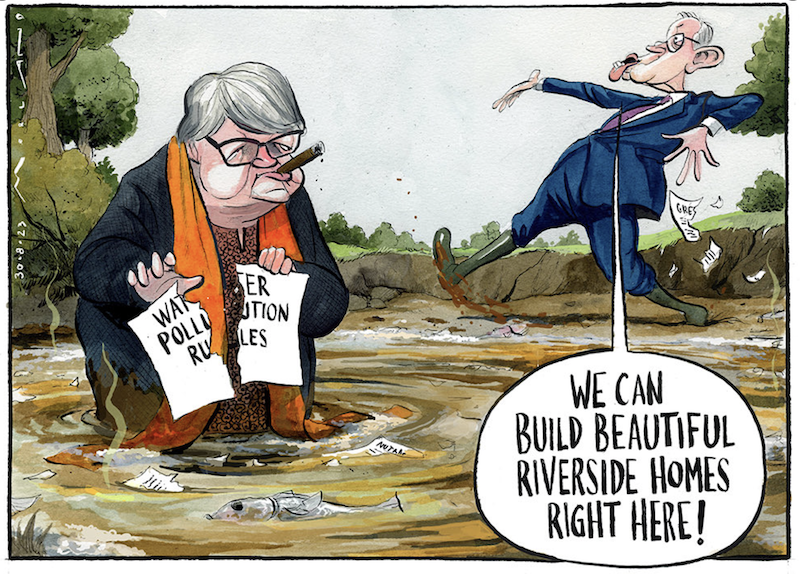
Source: Morten Morland.
I came across a YouTube video by The Guardian cartoonist Martin Rowson in which he talks about William Hogarth and satire in general during the 18th century. It is very relevant to this research point as he shows examples of his own work which are, at their core, reworked versions of Hogarth’s illustrations in the context of the present day. A couple of observations made by Rowson during his speech that were helpful in summing up the ‘point’ of satirical illustrations were, firstly, that it gives the illustrator the power to take back control from the authority figure/institution that is being ridiculed. Secondly, often the only thing in life you can do is laugh at a hopeless situation.
Selection of Illustrations
As I have previously explored quite a selection of Hogarth’s work during the course, for this exercise I decided to look at the two alternative artists suggested – James Gillray and George Cruikshank.
I looked through a range of both artists’ work and picked a few that I thought had the potential to be reworked in the present day.
The first image is by James Gillray, entitled Temperance enjoying a frugal meal (1792), which I learnt depicts King George III and his wife, Queen Charlotte, and mocks their tendency for restraint and abstinence from excesses by showing them eating a ‘miserly’ meal in a clearly wealthy setting. I quite liked how the tablecloth was tucked in under the George’s chin, replacing a napkin. I am sure there is more depth and meaning to this image, but I found it quite complicated to understand all the details and connotations.
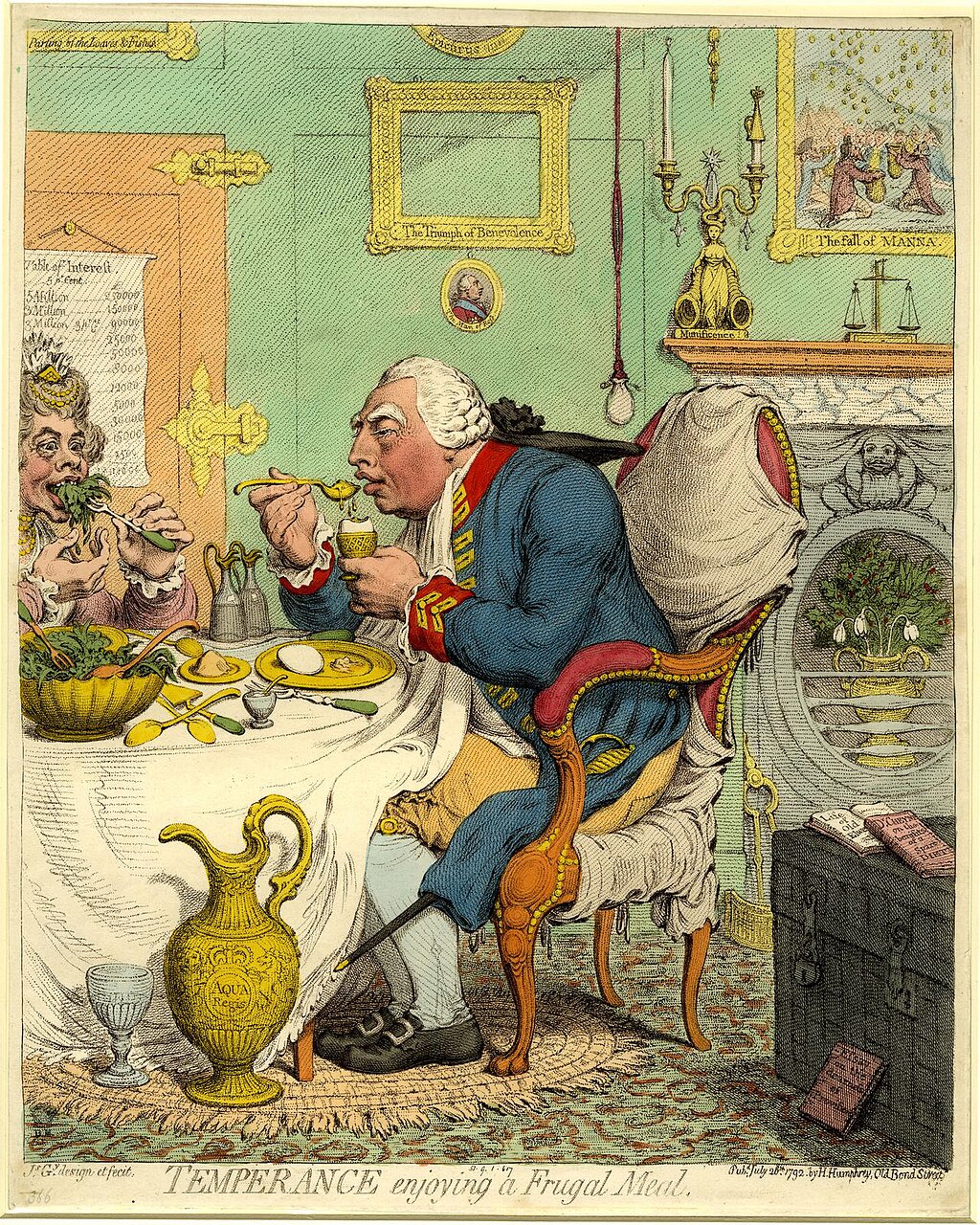
Source: British Museum, Public domain, via Wikimedia Commons
In terms of it being reworked in the context of today, I thought it would be possible to show the current king, Charles III, in similar fashion as he is known for his environmental concerns and restraints, such as turning off lights in the palaces and turning down the temperature of Buckingham Palace swimming pool. I would like to point out that I agree with his thoughts about the environment/climate change/living frugally, so I would not see it as an ‘attacking’ cartoon.
The second illustration I chose was also produced by Gillray and is entitled The Monster Going to Take his Afternoon’s Luncheon (1790). This image refers to a period in London during early 1790 when a ‘well-dressed gentleman’ would approach women and start talking to them, unpleasantly, before stabbing them in the thigh or cutting across their legs. The image by Gillray is quite shocking and graphic, but it definitely is impactful.
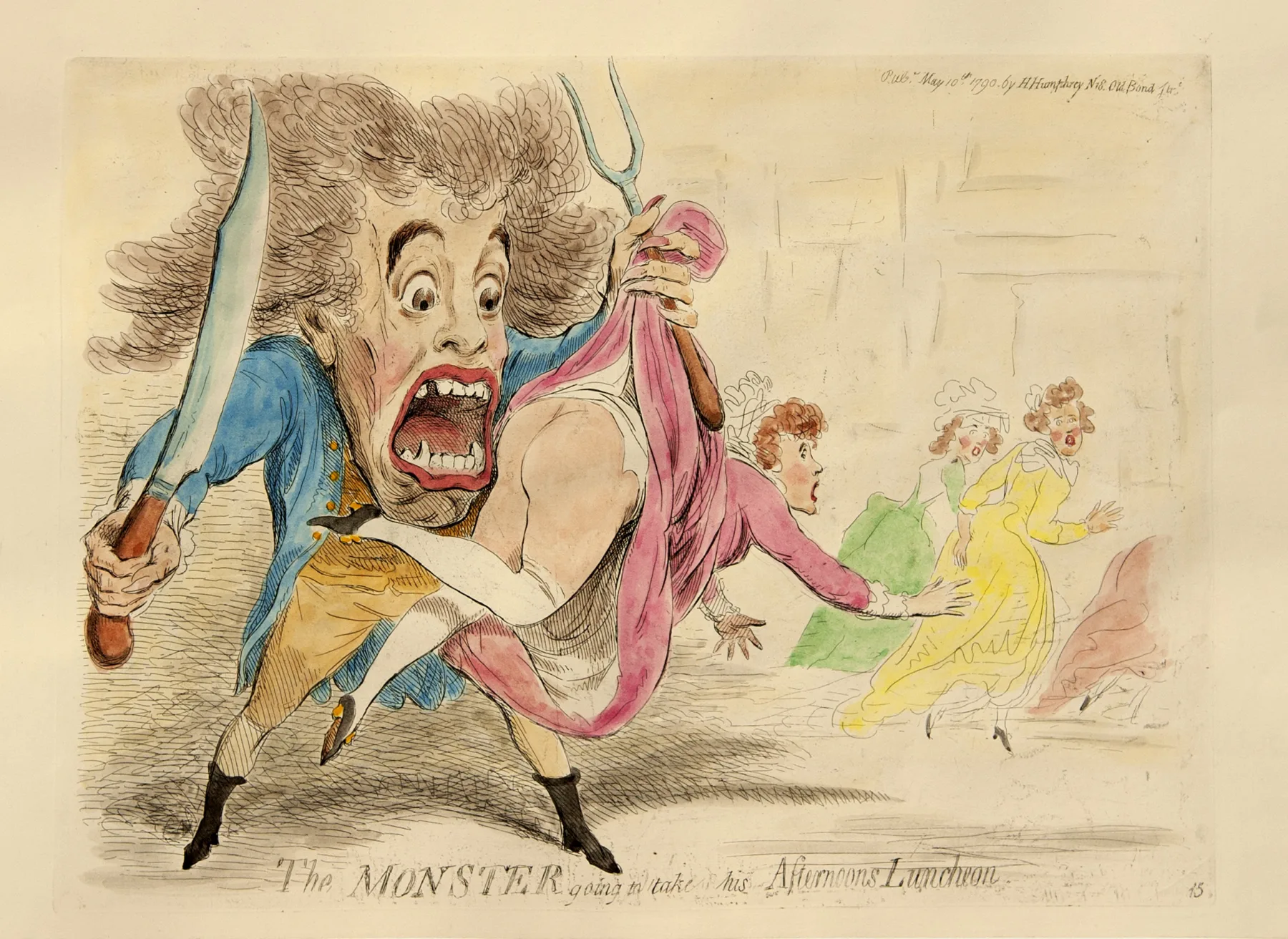
In terms of reworking this for the present day, I thought it was highly relevant with the safety of women being a primary concern for many due to the recent number of high-profile attacks and murders that have taken place in London. Of course, unfortunately, these violent assaults on women have always occurred in the UK and across the world, but due the aforementioned events, it is currently a ‘hot topic’.
The third illustration I selected is another by Gillray, entitled The Plumb-pudding in danger (1805). In simple terms, it depicts the British Prime Minister of the time, William Pitt, and the Emperor of France, Napoleon, seated at a table carving up the world. I thought that even without having a deep knowledge of the political angles of the illustration, which I do not, it is a really powerful illustration that shows how the greed of a select number of powerful individuals has potential for impact on a global scale.
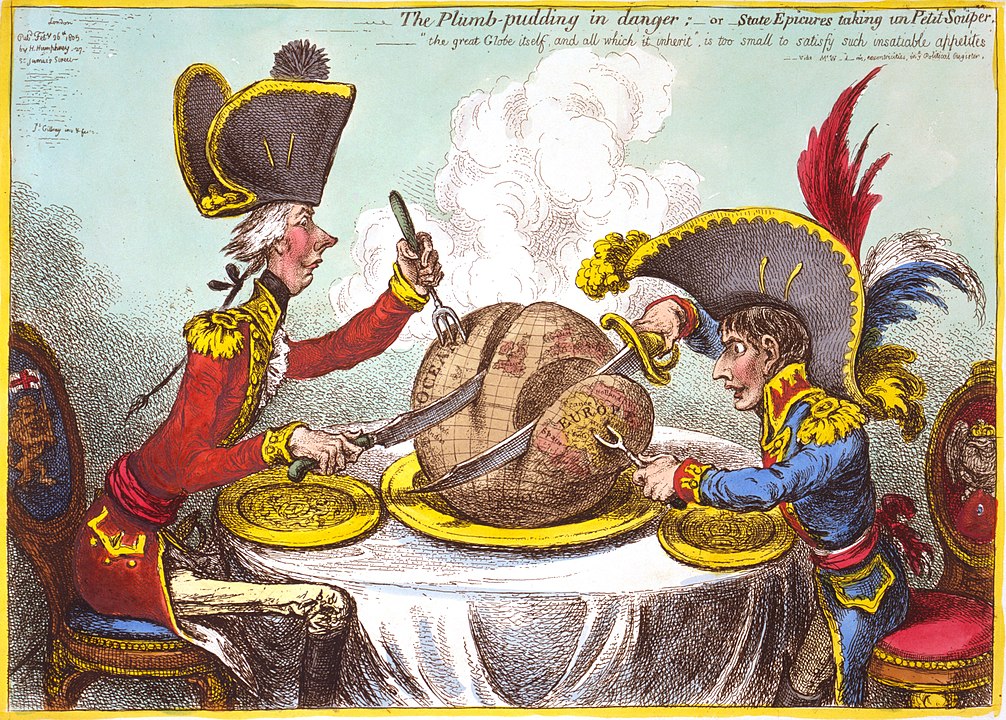
Source: Wikipedia
I thought this illustration could quite easily be reworked for the present day, as, in my opinion, it is still completely relevant, which is really quite sad. A new version would obviously have a different cast of characters and there would be more of them. I do not find it surprising that they would still be, if not all, then mostly men. I also think it would be possible to do a version that had some non-political leaders as the characters, such as billionaires Elon Musk and Jeff Bezos, in the image, or silhouettes of people in the background (who influence those ‘in power’, such as lobbyists). Perhaps they could be dividing up the planets in space rather than Earth, as they all seem so intent on messing up another one!
I found most of George Cruikshank’s illustrations particularly difficult to interpret but an example of one that I ‘got’ the general notion of is entitled Merry making on the regents birthday (1812). I learnt that this image shows the very same George III in the one previously discussed by James Gillray, although George does not look very restrained to me in this illustration!
The main message I interpreted from this illustration is that the powerful and rich are having a merry time in their palaces, whilst the ‘common’ people outside are struggling to survive.
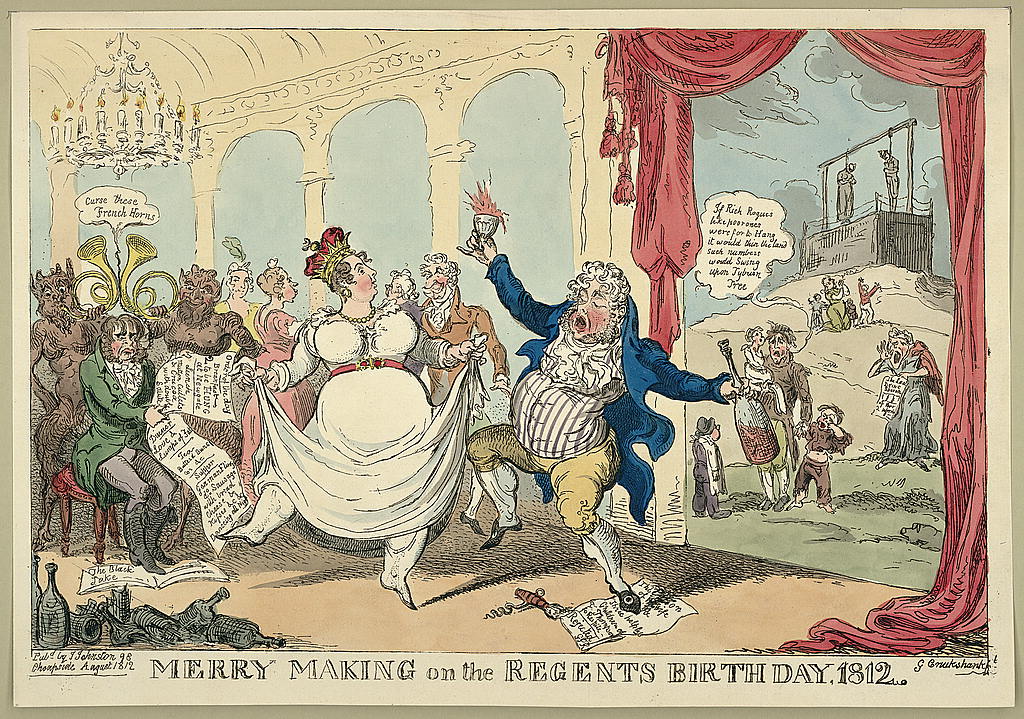
Source: Library of Congress
I thought this concept was very pertinent (as it has always been) in the present day, both on a national and international scale, with those select individuals in charge becoming more powerful and wealthy, whilst everyone else is left trying to get by. The image could almost be identical, just replaced with modern characters. I would also include the effects of climate change outside as well, perhaps wildfires, droughts or people drowning as the sea levels rise (there are plenty of options to choose from).
Final Thoughts
I found this research point to be quite eye-opening in terms of how timeless satire can be – this could actually be seen as quite depressing as it shows that nothing really changes, but as Rowson states, sometimes all you can do is laugh!
It was definitely worthwhile finding some examples to consider how they could be reworked in the present day. It is useful to now realise that I could potentially use these illustrations as reference for future images I may produce.
Perhaps what I found most interesting was that even though I did not understand all the specifics of what the original illustrations were referring to as they were historical events, they still clearly work on a basic level. I could interpret the gist of the artist’s messages, which makes them timeless, and that is what this research task was about.
Bibliography
Bell, S. (n.d.) Belltoons – The Steve Bell Cartoons Website. Available at: https://www.belltoons.co.uk (Accessed 25 August 2023).
Cultural and Education Section (2016) Martin Rowson: “William Hogarth and Laurence Sterne: satire in the XVIII London”. Available at: https://www.youtube.com/watch?app=desktop&v=K61-HVjSDAQ (Accessed 25 August 2023).
Library of Congress (n.d.) Merry making on the regents birth day, 1812 / G. Cruikshank. Available at: https://www.loc.gov/resource/ppmsca.04317/?st=image (Accessed 26 August 2023).
Ng, K. (2023) King Charles ‘turns down temperature in Buckingham Palace swimming pool’. Available at: https://www.independent.co.uk/life-style/royal-family/king-charles-swimming-pool-temperature-b2347356.html (Accessed 25 August 2023).
Rowson, M. (n.d.) Martin Rowson. Available at: https://www.martinrowson.com/welcome (Accessed 26 August 2023).
Sherry, J. (2023) James Gillray: Caricaturist: Temperance Enjoying a Frugal Meal. Available at: https://www.james-gillray.org/pop/temperance2.html (Accessed 25 August 2023).
The British Library (n.d.) ‘The Plumb-pudding in danger – or – State Epicures taking un Petit Souper’ by Gillray. Available at: https://www.bl.uk/collection-items/the-plumb-pudding-in-danger—or—state-epicures-taking-un-petit-souper-by-gillray (Accessed 25 August 2023).
Twitter (n.d.) Guy Venables. available at: https://twitter.com/godfreychurch (Accessed 25 August 2023).
Twitter (n.d.) Morten Morland. Available at: https://twitter.com/mortenmorland (Accessed 25 August 2023).
Twitter (n.d.) Nick Newman. Available at: https://twitter.com/Ncknwmn (Accessed 25 August 2023).
Wikimedia Commons (n.d.) File:Temperance enjoying a frugal meal (BM 1851,0901.617).jpg. Available at: https://commons.wikimedia.org/wiki/File:Temperance_enjoying_a_frugal_meal_(BM_1851,0901.617).jpg (Accessed 26 August 2023).
Wikipedia (n.d.) The Plumb-pudding in danger. Available at: https://en.wikipedia.org/wiki/The_Plumb-pudding_in_danger (Accessed 25 August 2023).